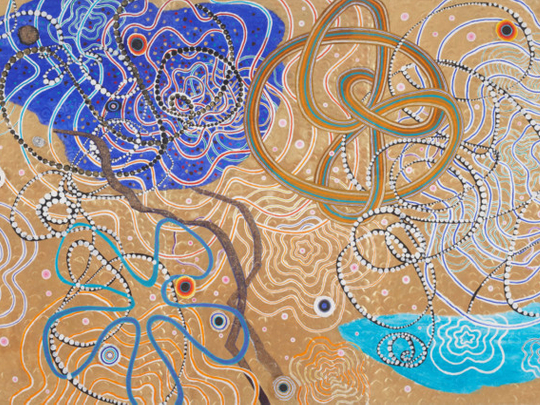
Renowned Lebanese artist Nabil Nahas is recognised as a master of colour, texture and atmosphere. He is best known for his three-dimensional paintings featuring moulded starfish, clam shells and other shapes fixed on the canvases. The artist’s latest exhibition in Dubai features three-dimensional works from his “Fractals” and “Galactic” series. The rough, encrusted surfaces of his paintings represent microcosmic and macrocosmic perspectives of the Universe and invite viewers to look deeper and find some order in the chaos around us.
Nahas began the “Fractals” series in the 1990s. The term “fractals” is based on the Latin “fractus”, which means fractured or broken. This term was first used by mathematician Benoit Mandelbrot in the 1970s to describe rough or fragmented geometric shapes that can be split into smaller parts, each of which is a smaller-scale copy of the whole. Mandelbrot used fractal mathematics to find order in complex irregular elements found in nature such as clouds and coastlines.
In his “Fractals”, Nahas uses a mixture of ground pumice and acrylic paints to create layers of repetitive biomorphic shapes that make the surface look like encrustations seen in the natural world. In the latest works, his use of a predominantly blue palette alludes to shorelines and the seabed, with the smaller paintings looking like windows into an underwater world of coral reefs, and the larger pieces resembling gigantic sea monsters.
The fact that these rough irregular surfaces could be seen as the encrustations on the surface of a huge sea creature or they could be miniscule irregularities visible under a powerful microscope is a play on the idea of fractals that look the same at every scale. The artworks thus reflect the fine balance between order and disorder and represent a kind of asymmetrical equilibrium.
In contrast with the serene blues and rather rigid shapes of the “Fractals”, Nahas’s “Galactic” paintings are filled with bright colours, fluid forms and sinuous lines. Once again, these lines and forms could represent a macroscopic view of heavenly bodies and galaxies in outer space as well as miniscule amoebic life forms as seen under a powerful microscope. Adding colour and texture to these paintings are a number of vividly coloured concentric rings fixed on the canvases. These are actually dried chunks of the pumice and paint mix that Nahas uses for his “Fractals”. The artist scrapes them off the studio floor and recycles them, thus creating a connection between the two series, while also revealing the unseen process behind the “Fractals”.
Nahas’s three-dimensional artworks are beautiful and profound. But the artist has also infused them with humour by giving them playful titles such as “Twizzler”, “Serendipity”, “Inka Dinka Doo” and “Mashallah” — the last one being a reference to what viewers usually say on seeing the stunning pieces.
Jyoti Kalsi is an arts enthusiast based in Dubai.
“Nabil Nahas” will run at Lawrie Shabibi gallery until January 9, 2014.
BOX
Weaving Gaps
By Jyoti Kalsi
Dubai-based Italian-Lebanese artist Cristiana de Marchi’s favourite medium is embroidery. In her first solo exhibition in the city, “Weaving Gaps” she has explored issues of identity, national pride and the transition between territories and contexts, through a series of videos and installations based on embroidery.
Maps, flags, anthems and passports appear in the artworks as symbols of nationality and identity. In an audio piece the artist has combined various national anthems to create a cacophony of sounds. And in a set of monochrome works, featuring different flags embroidered with white thread on white canvases she appeals for peace and harmony.
She pays tribute to late Sheikh Zayed with his iconic words “I dreamt of our land keeping pace with the growth of the modern world” embroidered on newspapers bearing his picture. And she refers to her strong relationship with Beirut in two pieces based on a Google map of the city. In “You are here” de Marchi has removed the red dot indicating the viewer’s position from her embroidered map, to create a sense of disorientation that comments on the history of civil strife in the city. The same map is engraved on bars of soap in “Soap Opera”.
“The shape of this installation was determined by the location of the Sunni, Christian and Shiite neighbourhoods that I wanted to connect. After this show, I am going to dissolve this installation in water, washing away the conflicts and merging the different areas into one harmonious whole,” she says.
The artist also plays with the idea of the artificiality of borders in a video where she is seen embroidering and then undoing the word “borders”. “Undoing is always more difficult than doing, and however carefully you remove the stitches, traces of the embroidery will always remain on the fabric,” she says.
In another video she is seen doing, undoing and redoing the words “Al Watan” (Arabic for “the Nation”). “In the Middle East, the term Al Watan evokes strong emotions associated with belonging, identity and self-affirmation. But recent events have shown that the concept of a nation is not stable and must be constantly negotiated. This piece is a metaphor for the cycle of building, destroying and rebuilding of nations that is happening today, and it emphasises the fact that removing and untangling the thread is a difficult process,” de Marchi says.
“Weaving Gaps”, presented by 1x1 gallery, will run at Empty 10 gallery until December 31.












